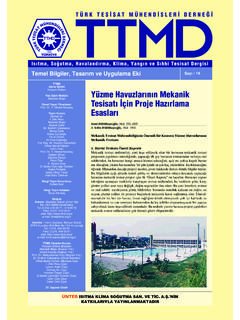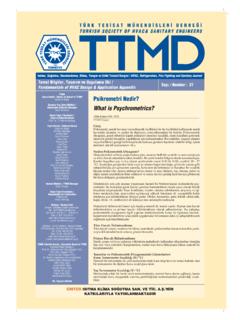Transcription of Dr. Andrey Livchak Halton Foodservice
1 Dr. Andrey Livchak Halton Foodservice Facts Restaurants are among the buildings with the highest energy intensity in commercial sector. In the US alone there are 900 thousand restaurants employing over 12 million people Labor and training costs for restaurants continue to rise with the average employee turnover exceeding 100% Thermal comfort survey From ASHRAE report RP1469 Thermal Comfort in Commercial Kitchens Thermal Comfort & Productivity Effect of productivity on profit Based on data from National Restaurant Association Productivity of kitchen personnel increased by 25% Productivity of kitchen personnel dropped by 25% Typical restaurant energy consumption HVACK itchen EquipmentLightingCooler Freezer & otherCooking process and HVAC system contribute up to 80% of total restaurant energy consumption. Start from the heat source cooking equipment Low efficiency appliances with high energy output add more heat to space, require higher ventilation rates and result in higher HVAC energy consumption.
2 Adding 10 kW to appliances energy input may double contribution to the whole building energy consumption to 20 kW due to its effect on HVAC system. Kitchen energy consumption is driven primarily by cooking process & equipment Use more efficient cooking process Convection ovens Induction cooking Use best-in-class ENERGY STAR and California utility rebate qualified appliances ventilation Design Customize ventilation design for the cooking process and equipment. Design objective is to minimize outdoor air usage whenever cooling or heating is required. Energy and environmental impact of increasing outdoor airflow by 100 l/s City, State Electricity Consumption Gas Consumption CO2 emissions kWh kWh kg Innsbruck, AUT 590 5707 242,5 Helsinki, FIN 571 9107 262,1 Paris, FRA 592 4297 180,6 Berlin, DEU 606 5527 549,0 Rome, ITA 681 1371 439,2 Warsaw, POL 592 6586 846,6 Moscow, RUS 575 9070 429,5 Madrid, SPA 809 2678 466,8 Basis for calculation: Restaurant operates from 7:00 to 23:00 seven days a week.
3 Electricity consumption is calculated based on energy required to operate supply and exhaust fans to move additional 100 l/s of air and energy consumption by compressor of refrigeration system to cool outside air in summer down to kitchen indoor air conditions (24 C, 50% relative humidity). Calculation of gas consumption is based on amount of gas required to heat the make-up air in winter to 18 C. ventilation design Open the door and then switch on air conditioner! How much exhaust is enough? Terminology Replacement air all air supplied to the restaurant to compensate for hood exhaust Replacement Air = Total Hoods Exhaust Make-up air outside air introduced to kitchen space to completely or partially compensate for hood exhaust Transfer air air being transferred from adjacent spaces to kitchen to compensate for hood exhaust Make-up Air + Transfer Air = Replacement Air ventilation Design Common mistakes: front of the house (dining room) and back of the house (kitchen) are treated as two separate spaces with individual, often independent, ventilation systems.
4 Often engineer attempts to minimize amount of outside air in the dining room while using massive amounts of it in the kitchen. Common Design Using standard roof-top packaged equipment designed for offices and not prepared to deal with high enthalpy of return air and high outside airf lows. ventilation Design Good practice: Utilize whole building approach Minimize use of outside air for the whole building Utilize transfer air to compensate for hoods exhaust when available Whole Building Approach Total requirement for outside air is calculated based on the dining room and kitchen demand. A dedicated outside air handling unit pre-treats all outside air for the building. OA moisture is no longer a problem. Control system optimizes whole building air conditioning system for minimum energy consumption Minimize exhaust airflow Hood exhaust airflow defines HVAC energy consumption Reduction of hood exhaust airflow provides: Saving of fan motor energy consumption Reduction of HVAC system energy consumption to condition (heat and cool) replacement air How to reduce hood exhaust airflow Position cooking appliances close to the walls, avoid island installations when possible Enclose appliances with the walls Use high efficiency, close proximity hoods Use Demand-Controlled ventilation (DCV) Use Efficient Air Distribution Systems Thermal Displacement ventilation TDV allows reducing hood exhaust airf low and improve thermal comfort Appliance position in a kitchen and type of hood being used has a major effect on exhaust airflow A appliances in the middle of the space with canopy island hood.
5 B appliances in the corner with canopy wall hood; C appliances at the wall with canopy wall hood; D appliances at the wall with close proximity back-shelf hood. ABCDHood exhaust airf low, m3/s A D C B Use high efficiency hoods Demand-Controlled Kitchen ventilation DCV Demand-Controlled ventilation DCV is a control system that regulates hood exhaust airf low and make-up air based on demand from cooking process. Appliance status Hood status Cooking Operates at design airflow Idle Modulates below design airf low Off Off Quick Serve / Chain Restaurants 43% Airflow Reduction Overview of the DCKV study One of the key challenges of implementing DCV systems in the field is to ensure that the hoods are operating at capture and containment (C&C) airf lows when the appliances are in a cooking mode. Data is presented on how different appliances can require additional detection methods to ensure that the hood is running at a proper airf low.
6 Secondly, a case study is presented on the design challenge of how to incorporate a DCV system in a restaurant which has a combination of hoods with dedicated exhaust fans and hoods that share exhaust fans; and how to optimize the energy consumption of these systems. From Demand Controlled ventilation for Commercial Kitchens ASHRAE Journal, November 2012 Two types of DCKV Temperature only , without cooking activity sensor Have lower energy saving potential due to limited ability to identify when cooking starts and ramp hood exhaust airf low to design airf low level With cooking activity sensors These are more sophisticated systems that utilize additional sensors to identify appliance status Griddle Testing From Demand Controlled ventilation for Commercial Kitchens ASHRAE Journal, November 2012 DCV Response Time temperature-only system From Demand Controlled ventilation for Commercial Kitchens ASHRAE Journal, November 2012 DCV Response Time system with cooking activity sensor From Demand Controlled ventilation for Commercial Kitchens ASHRAE Journal, November 2012 DCV Testing Comparison of time to reach design airflow.
7 Appliance Time from start of cooking (seconds) when design airf low reached System with Cooking Activity Sensor Temperature Only System Open Vat Fryer 23 NA Griddle 35 174 Rethermalizer 26 NA Pressure fryer 28 NA Char-Broiler 23 NA From Demand Controlled ventilation for Commercial Kitchens ASHRAE Journal, November 2012 DKCV and balancing dampers Systems that couple multiple hoods to a single exhaust fan need a means of independently regulating exhaust airf low for each hood to maximize energy savings DCV Case Study Evaluated Site Configuration Four canopy hoods attached to single exhaust fan Demand control ventilation installed Design Exhaust Airflow = 11,290 CFM ( m3/s) Balancing dampers installed on each hood to independently regulate exhaust proportional to demand DKCV case study With dampers Without dampers From Demand Controlled ventilation for Commercial Kitchens ASHRAE Journal, November 2012 Almost 2x airflow reduction for system with balancing dampers DKCV Case Study Energy Impact System Savings Heating [kWh] Cooling [kWh] Exhaust Fan [kWh] Supply Fan [kWh] DCV w/ dampers 38300 7425 38075 12692 DCV w/o dampers 12778 2475 15705 5235 Increased savings with dampers 25526 4950 22370 7457 +200% +200% +142% +142% Location: Seattle, WA Operating Hours: 24/7 Heating EFF: 90% COP.
8 From Demand Controlled ventilation for Commercial Kitchens ASHRAE Journal, November 2012 Mixing ventilation Thermal Displacement ventilation TDV Air Distribution Air distribution system has important effect on hoods performance (C&C exhaust airflow) The higher velocity in the space, especially near the hood, the higher hood C&C airflow. It is easy to extinguish a candle by blowing on it, but try sucking it in Two types of air distribution systems Mixing ventilation Traditional mixing systems supply air at high velocity. The goal is to thoroughly mix supply and room air to achieve a uniform space temperature. Thermal Displacement ventilation (TDV) TDV supplies cool fresh air with low velocity in the occupied zone Natural buoyancy forces displace heat and contaminants into the upper, unoccupied part of the room TDV Supply air moves from low velocity diffusers towards the heat source and then rises to the upper part of the space in the heat plume above the heat source.
9 Mixing ventilation performance in kitchen TDV performance in kitchen Benefits of TDV TDV is a unique system because it allows improving indoor environmental quality and save energy at the same time TDV allows to reduce temperature in occupied zone by 2 - 5 C Hoods can operate at 15% lower exhaust airflow due to absence of cross-drafts ASHRAE Energy Standard for Buildings Except Low-Rise Residential Buildings Purpose: Establish the minimum energy efficiency requirements of buildings, other than low rise residential buildings, for: 1. design, construction, and a plan for operation and maintenance, and 2. utilization of on-site, renewable energy sources. Has been the benchmark for commercial building energy codes in the United States and a key basis for standards in more than 15 countries around the world. Has become Code Language since 2001 Used and referenced extensively in Model Codes (IECC, IMC,..) Used for incentive and rebate programs Current Publication 2013 (3-year update cycle) Prerequisite for LEED certification ASHRAE in CKV 2010 Changes for Commercial Kitchen ventilation Promotes efficient kitchen hoods and energy efficiency without penalizing indoor environment Re-written with collaboration of TC and restaurant industry experts Requires at least one energy conservation measure for kitchens that exhaust more than 5000 CFM ( Heat recovery, demand control ventilation , maximum use of transfer air) Reduces exhaust requirements from the norm by 30% or more ( norm by ASHRAE 154 Standard) ASHRAE Kitchen Exhaust Systems Replacement air introduced directly into the hood cavity of kitchen exhaust hoods shall not exceed 10% of the hood exhaust airf low rate.
10 (Short Circuit/Cycle Hoods) Conditioned supply air delivered to any space with a kitchen hood shall not exceed the greater of: A. The supply f low required to meet the space heating or cooling load B. The hood exhaust f low minus the available transfer air from adjacent spaces. Available transfer air is that portion of outdoor ventilation air not required to satisfy other exhaust needs, such as restrooms, and not required to maintain pressurization of adjacent spaces. Short-Circuit Hoods Still represent about 20% of the market Effectively abolished by current energy efficiency standards Not to confuse with high efficiency hoods with activated air curtain Photo from 2011 ASHRAE Handbook HVAC Applications ASHRAE If a kitchen/dining facility has a total kitchen hood exhaust airf low rate greater than 5,000 cfm (2360 l/s) then each hood shall have an exhaust rate that complies with Table If a single hood, or hood section, is installed over appliances with different duty ratings, then the maximum allowable f low rate for the hood or hood section shall not exceed the Table values for the highest appliance duty rating under the hood or hood section.



